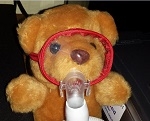I know cleaning your CPAP equipment is a highly personal issue and there are people who rarely clean anything except their mask once in a while and they never have a problem. However, I did find this article which I found to be the best and works for me.
CPAP Equipment Cleaning & Disinfecting Schedule and Instructions
Attention: Cleaning and Disinfecting your respiratory equipment is essential to the life of the equipment and to your health.
Whenever moisture is present, from water supplies, from body humidity, or any bodily fluid, bacteria can grow. If your equipment is not properly cleaned and dried, bacteria builds up and can lead to infections in your body, especially in your airway passages. Also, the oils in your skin and the minerals in tap water can cause premature breakdown in the materials used to manufacture your CPAP equipment, especially your mask. Therefore, we recommend the cleaning and disinfection schedule be followed diligently.
Daily cleaning removes dirt and oils that may harbor germs. Disinfection actually kills germs that may lead to infection. Remember, always wash your hands prior to handling your CPAP equipment.
To wash your CPAP equipment:
Only use a mild, non-lotion detergent. Do not use soap or strong dish washing detergents such as Dawn or Joy. Avoid detergents that use strong perfumes or dyes. We recomend using a dishwashing detergent like Ivory Clear, Palmolive, or Dial Anti-Bacteria for cleaning your equipment.
To disinfect your equipment:
Mix 1/2 oz. (1 tablespoon) of Control III with 2quarts of water in a plastic container. The solution can be reused for up to 14 days. If the solution becomes visibly dirty, make a fresh batch. First wash and rinse your CPAP equipment, then soak it in the Control III solution for 10 minutes. Rinse thoroughly (allow water to run for 3 minutes) with tap water and then allow to air dry. Cover dried parts with a clean towel until the equipment is reassembled. To dry your CPAP tubing, hang over a doorknob or hanger. Alternative to Control III - Wash equipment with warm, soapy water, rinse and then soak equipment in a 50/50 solution of white distilled vinegar and water for 15 to 30 minutes. Rinse well and dry as instructed above.
Drying Hints:
Always hang tubing away from direct sunlight, as this will cause the tubing to become yellow, brittle and crack over a period of time. DO NOT attach the wet tubing to your CPAP unit to blow-dry it. The moisture from the tubing can drain back into your machine. Moisture in your unit can cause sudden pressure increases or short circuits.
Cleaning the CPAP unit:
- Unplug the unit before cleaning it.
- Never immerse the unit in water.
- Using a cloth slightly dampened with water and dish detergent, wipe the outside of the unit.
- Using a cloth dampened with water only, wipe the outside of the unit again.
- Use a dry cloth to wipe the unit and then let it air dry.
- Make sure the unit is thoroughly dry before plugging it in.
Cleaning and Disinfecting the Humidifier:
DAILY
- Empty any remaining water after each use.
- Never immerse the unit in water.
- Wash your hands.
- Immerse the humidifier in warm, soapy water.
- Fill the humidifier with the soapy water and shake the humidifier vigorously.
- Rinse with clean water and allow to air dry.
WEEKLY
- Mix disinfecting solution (1 tablespoon disinfectant per 2 quarts water).
- Soak the humidifier in disinfectant for 10 minutes.
- Be sure the disinfectant completely covers and fills the humidifier.
- Remove the humidifier and shake out the excess solution and rinse with distilled water.
- Allow to air dry.
DO's and DON'Ts:
- Don't use alcohol-based products to clean your mask, because it can cause the materials to become hard and brittle.
- Do follow the recomended cleaning schedule.
- Don't use any caustic or household cleaning solutions such as bleach on your CPAP equipment.
- Do change your disposable filter frequently.
- Don't put headgear in the washer or dryer.
CPAP Equipment Cleaning and Disinfecting Schedule
Equipment Cleaning Frequency Instructions Disinfecting Frequency
Non-Disposable Filters (gray) Weekly Mild soapy water, Rinse, Air Dry Not Required
Disposable Filters Change as needed
1 to 2 months Do Not Wash Not Required
Hose (without humidifier) Monthly Mild soapy water, Rinse, Air Dry Not Required
Hose (with humidifier) Weekly Mild soapy water, Rinse, Air Dry Once a week
Mask / Nasal Pillows Daily Mild soapy water, Rinse, Air Dry Once a week
Headgear As Needed Hand wash, Mild soapy water, Rinse, Dry Not Required
Humidifier Daily Empty water daily
Mild soapy water, Rinse well, Air Dry Once a week
CPAP Unit As Needed Dust with damp cloth,
No detergents or sprays
Cleaning CPAP equipment: Best Practices
Re: Cleaning CPAP equipment: Best Practices
You must have a lot of spare time on your hands.
_________________
| Machine: ResMed AirSense™ 10 AutoSet™ CPAP Machine with HumidAir™ Heated Humidifier |
| Mask: Fisher & Paykel Vitera Full Face Mask with Headgear (S, M, or L Cushion) |
| Additional Comments: Back up is S9 Autoset...... |
- SleepWellCPAP
- Posts: 370
- Joined: Fri Mar 22, 2013 11:44 am
- Location: Naples Florida
- Contact:
Re: Cleaning CPAP equipment: Best Practices
I agree with LSAT.
Now that your equipment is perfectly clean, , the most often overlooked element in the "cleaning" equation is your face. Oils and acids from your skin should be washed from the mask, but also from your skin prior to applying the mask.
Facial cleaning or lack of, is the number one common issue I have noticed over the years that people tend not to keep up with. A clean face is critical when it comes to getting the most out of your equipment.
Now that your equipment is perfectly clean, , the most often overlooked element in the "cleaning" equation is your face. Oils and acids from your skin should be washed from the mask, but also from your skin prior to applying the mask.
Facial cleaning or lack of, is the number one common issue I have noticed over the years that people tend not to keep up with. A clean face is critical when it comes to getting the most out of your equipment.
Jim Swearingen
Author of the book Sleep Well & Feel Great with CPAP, a definitive guide
For a free copy inquire with your local county librarian
CPAPtalk featured - Also available through Barnes & Noble Booksellers
Author of the book Sleep Well & Feel Great with CPAP, a definitive guide
For a free copy inquire with your local county librarian
CPAPtalk featured - Also available through Barnes & Noble Booksellers
Re: Cleaning CPAP equipment: Best Practices
Well, what do you know... I found an excellent post about this topic right here in the forum's "CPAP Wiki".
wiki/index.php/Cleaning_CPAP_Equipment
It does an excellent job of "respecting" the merits of both sides of the argument. Honestly, there is no reason whatsoever that this topic should fuel a "One side is right, and the other side is a bunch of idiots!" type of mentality.
wiki/index.php/Cleaning_CPAP_Equipment
It does an excellent job of "respecting" the merits of both sides of the argument. Honestly, there is no reason whatsoever that this topic should fuel a "One side is right, and the other side is a bunch of idiots!" type of mentality.
_________________
| Machine: Somnetics Transcend Micro Travel Machine |
| Mask: SleepWeaver Advance Small Soft Cloth Nasal CPAP Mask with Headgear |
| Additional Comments: Pressure = 10.5 - 13.5 (Wisp > Quattro FX for Her > SleepWeaver Anew > SleepWeaver Advanced) |
Sleep Study AHI = 70.5
Re: Cleaning CPAP equipment: Best Practices
Thanks, a very thorough and thought-provoking article. I do wash most things daily because they smell better and also because I have a lot of hairy critters that shed regardless of furminators and such. Every time I wash my mask in a white plastic basin, the water remaining often has quite a few black hairs from a little dog named Lukie who loves to climb all over me for cuddles before bed leaving a layer of black hair everywhere.
Re: Cleaning CPAP equipment: Best Practices
LSAT is the kind of person that I expect could be covered in elerbury wounds and mud and say in the best monty python voice "tis only a flesh wound"
Different people have different needs.
If you have too much desire to clean your machine, there is a very good chance that the noise reduction foam inside the machine is home to something you don't want there. If you have a resmed machine, too bad since opening it to clean it breaks it because they don't understand the customer value of a concept called a "screw".
//Resmed, I will get my foam tested in a lab, and I will publish the results before I let you know about it. You should fix this problem now.
Different people have different needs.
If you have too much desire to clean your machine, there is a very good chance that the noise reduction foam inside the machine is home to something you don't want there. If you have a resmed machine, too bad since opening it to clean it breaks it because they don't understand the customer value of a concept called a "screw".
//Resmed, I will get my foam tested in a lab, and I will publish the results before I let you know about it. You should fix this problem now.
_________________
| Mask: AirFit™ N20 Nasal CPAP Mask with Headgear |
| Humidifier: S9™ Series H5i™ Heated Humidifier with Climate Control |
| Additional Comments: Resmeds overpriced SpO2 |
-
Guest
Re: Cleaning CPAP equipment: Best Practices
now you know the rest of the storyLukie wrote:Thanks, a very thorough and thought-provoking article. I do wash most things daily because they smell better and also because I have a lot of hairy critters that shed regardless of furminators and such. Every time I wash my mask in a white plastic basin, the water remaining often has quite a few black hairs from a little dog named Lukie who loves to climb all over me for cuddles before bed leaving a layer of black hair everywhere.










